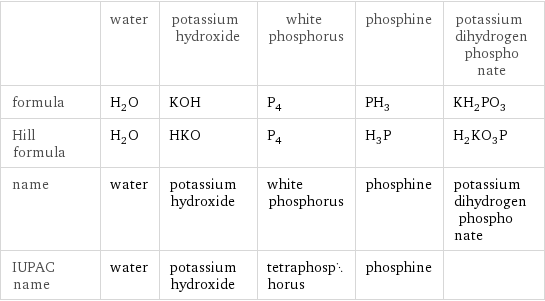Input interpretation

H_2O water + KOH potassium hydroxide + P_4 white phosphorus ⟶ PH_3 phosphine + KH_2PO_3 potassium dihydrogen phospho nate
Balanced equation

Balance the chemical equation algebraically: H_2O + KOH + P_4 ⟶ PH_3 + KH_2PO_3 Add stoichiometric coefficients, c_i, to the reactants and products: c_1 H_2O + c_2 KOH + c_3 P_4 ⟶ c_4 PH_3 + c_5 KH_2PO_3 Set the number of atoms in the reactants equal to the number of atoms in the products for H, O, K and P: H: | 2 c_1 + c_2 = 3 c_4 + 3 c_5 O: | c_1 + c_2 = 3 c_5 K: | c_2 = c_5 P: | 4 c_3 = c_4 + c_5 Since the coefficients are relative quantities and underdetermined, choose a coefficient to set arbitrarily. To keep the coefficients small, the arbitrary value is ordinarily one. For instance, set c_3 = 1 and solve the system of equations for the remaining coefficients: c_1 = 24/5 c_2 = 12/5 c_3 = 1 c_4 = 8/5 c_5 = 12/5 Multiply by the least common denominator, 5, to eliminate fractional coefficients: c_1 = 24 c_2 = 12 c_3 = 5 c_4 = 8 c_5 = 12 Substitute the coefficients into the chemical reaction to obtain the balanced equation: Answer: | | 24 H_2O + 12 KOH + 5 P_4 ⟶ 8 PH_3 + 12 KH_2PO_3
Structures

+ + ⟶ +
Names

water + potassium hydroxide + white phosphorus ⟶ phosphine + potassium dihydrogen phospho nate
Equilibrium constant
![K_c = ([PH3]^8 [KH2PO3]^12)/([H2O]^24 [KOH]^12 [P4]^5)](../image_source/e3a1e90f92318a50cdcfe9588fd96184.png)
K_c = ([PH3]^8 [KH2PO3]^12)/([H2O]^24 [KOH]^12 [P4]^5)
Rate of reaction
![rate = -1/24 (Δ[H2O])/(Δt) = -1/12 (Δ[KOH])/(Δt) = -1/5 (Δ[P4])/(Δt) = 1/8 (Δ[PH3])/(Δt) = 1/12 (Δ[KH2PO3])/(Δt) (assuming constant volume and no accumulation of intermediates or side products)](../image_source/13931d7fc892c74a7ba401619e59b7ae.png)
rate = -1/24 (Δ[H2O])/(Δt) = -1/12 (Δ[KOH])/(Δt) = -1/5 (Δ[P4])/(Δt) = 1/8 (Δ[PH3])/(Δt) = 1/12 (Δ[KH2PO3])/(Δt) (assuming constant volume and no accumulation of intermediates or side products)
Chemical names and formulas

| water | potassium hydroxide | white phosphorus | phosphine | potassium dihydrogen phospho nate formula | H_2O | KOH | P_4 | PH_3 | KH_2PO_3 Hill formula | H_2O | HKO | P_4 | H_3P | H_2KO_3P name | water | potassium hydroxide | white phosphorus | phosphine | potassium dihydrogen phospho nate IUPAC name | water | potassium hydroxide | tetraphosphorus | phosphine |
Substance properties

| water | potassium hydroxide | white phosphorus | phosphine | potassium dihydrogen phospho nate molar mass | 18.015 g/mol | 56.105 g/mol | 123.89504799 g/mol | 33.998 g/mol | 121.09 g/mol phase | liquid (at STP) | solid (at STP) | solid (at STP) | gas (at STP) | melting point | 0 °C | 406 °C | 44.15 °C | -132.8 °C | boiling point | 99.9839 °C | 1327 °C | 280.5 °C | -87.5 °C | density | 1 g/cm^3 | 2.044 g/cm^3 | 1.823 g/cm^3 | 0.00139 g/cm^3 (at 25 °C) | solubility in water | | soluble | insoluble | slightly soluble | surface tension | 0.0728 N/m | | | | dynamic viscosity | 8.9×10^-4 Pa s (at 25 °C) | 0.001 Pa s (at 550 °C) | 0.00169 Pa s (at 50 °C) | 1.1×10^-5 Pa s (at 0 °C) | odor | odorless | | odorless | |
Units
